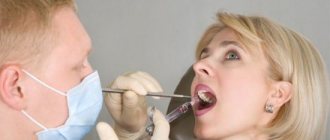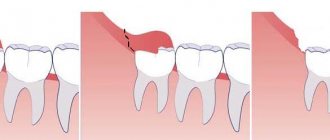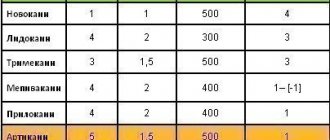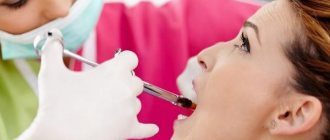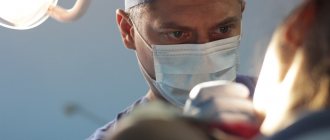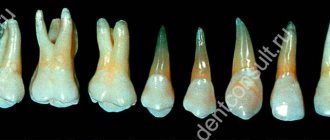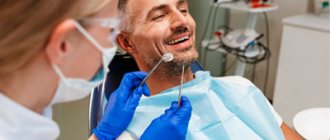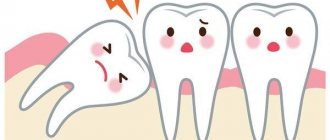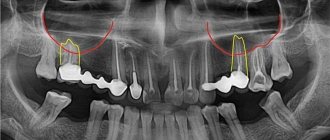Briefly about the indications for the preservation and removal of wisdom teeth
Don't believe anyone who says wisdom teeth are completely useless. They take on the chewing load, unloading other teeth, and, if necessary, can become a support for bridges.
Therefore, if the wisdom tooth does not bother you very much, occupies the correct position in the gum, and has good contact between the chewing surface and the teeth of the lower or upper jaw, such a tooth should be preserved.
Of course, there are many situations when a wisdom tooth must be removed. This applies to both erupted and unerupted wisdom teeth.
Wisdom tooth removal is necessary:
- when an inflammatory process occurs around the erupting wisdom tooth (mainly in the lower jaw), accompanied by swelling, severe pain and other symptoms;
- if the tooth is incorrectly positioned in the gum, in particular if its visible surface is tilted to one side;
- in case there is no longer room for the wisdom tooth in the jaw, and its eruption may displace other teeth and/or may destroy the adjacent tooth.
Wisdom teeth removal can be simple or complex.
Types of anesthesia
In modern dentistry, as a rule, two types of anesthesia are used:
- Local.
- Intravenous sedation.
Local anesthetics are the most common treatment for pain relief during dental procedures. They allow you to numb the local area of the oral cavity where the operation will be performed. However, the area of action of such drugs usually affects not only the tooth, but also adjacent tissues. For example, often after the administration of an anesthetic, numbness of the tongue, lips or cheek area appears.
Intravenous sedation is a treatment during sleep, when the patient is half asleep under the influence of drugs. The anesthesiologist carefully selects a prescription regimen taking into account your situation and your tests. It is important to clarify that this is not anesthesia in the form by which we understand it - the operation is carried out in a dental clinic, the patient breathes on his own and a couple of hours after the manipulation can go home; more details about sedation are written here. Indications for treatment under sedation will be:
- Severe fear in adults and children of dental surgery.
- For epilepsy.
- If the procedure takes a long period of time.
- Allergic reactions to topical drugs.
Any type of painkiller loses its effect over time, returning the body to its original state. The duration of action depends on the following factors:
- The nature of the substance.
- Method and correctness of drug administration.
- Individual characteristics of the patient.
- Place of injection.
Simple wisdom tooth removal in Khimki
After individual selection of anesthetic and anesthesia, the doctor removes the wisdom tooth in the same way as regular teeth are removed.
It should be borne in mind that even after a simple wisdom tooth removal, quite large holes remain. They are usually sutured to promote healing. In the case when a wisdom tooth is removed against the background of a purulent process, the sockets are not sutured to allow free outflow of purulent contents.
Without taking into account the effect of anesthesia, simple wisdom tooth removal takes from one to ten minutes. After 3-4 days, the patient comes for a follow-up appointment so that the doctor can make sure that recovery after removal is proceeding normally.
Advantages and disadvantages of the method
Compared to analog painkillers, carpule anesthesia has the following advantages:
- high-precision dosing;
- 100% sterility (a disposable needle is used for each injection);
- compliance of the capsule contents with antiseptic requirements;
- portability (due to its high thinness, the insertion of the needle is almost imperceptible);
- ease of administration in places where soft tissues are close to the periosteum;
- a design that is comfortable to hold in your hand and point in the desired direction;
- increased flexibility and strength of the needle, which eliminates the risk of injury;
- labeling of each carpule with the name and dosage of the drug.
No significant disadvantages of the method under consideration were found. For some patients, the disadvantage is the high cost of the drug, which is due to manufacturing costs and effectiveness. Any quality product has an appropriate price.
Another disadvantage is the limitation of formulation modification. It cannot be mixed with a vasoconstrictor, which is necessary in some clinical cases.
Features of application
The drug should only be used by an experienced doctor with knowledge of the pharmaceutical properties of pain medications. The packaging provides detailed information about the percentage of components of a particular drug.
The injection kit consists of:
- Anesthetic is a substance that reduces the pain threshold in the injection area. Most of these drugs belong to the group of amides (for example, articaine, prilocaine, lidocaine);
- vasoconstrictor - a substance that serves to activate vasoconstrictor functions, which increases the duration of the analgesic effect (for example, adrenaline or mesaton). The same substance slows down the process of leaching the drug from the work area.
Important! The vasoconstrictor should be prescribed with caution to patients suffering from cardiovascular diseases, diabetics, and elderly patients.
- antioxidants - sodium sulfites or bisulfites. Their task is to protect the vasoconstrictor from destruction that occurs when exposed to oxygen. They contain sulfur fragments and may cause an allergic reaction. Not used to treat patients with pathologies of the respiratory system;
- preservatives - necessary for the drug to retain its properties until opening;
- EDTA – a substance that binds metals;
- parabens - serve to ensure 100% sterility of the composition contained in the capsule, which is especially important for safe transportation to hot regions. The balanced composition ensures reliable protection of the injection from pathogenic microorganisms.
Additional recommendations
Before administering an injection to the working area, it is recommended to make sure that the patient is not allergic to the components of the medication. This will minimize the development of anaphylactic shock, which has a detrimental effect on the patient’s health.
Complex wisdom tooth removal in Khimki
If the wisdom tooth is difficult to reach, sits firmly in the jaw, erupts in the wrong direction, or does not erupt at all, then complex removal and strong anesthesia are required.
Depending on how the tooth erupted, various manipulations are performed, including incisions in the gums, drilling out bone tissue, removing the tooth and suturing the wound.
This operation can take quite a long time.
Sutures for difficult removal are made of non-absorbable material. They are removed after the edges of the wound have healed well.
The patient comes for a follow-up appointment within a couple of days after the operation, and usually they are not limited to one follow-up appointment.
Carpule anesthesia
Carpule anesthesia is anesthesia that uses a special syringe. It is used for comfortable and safe anesthesia. In modern dentistry, this method of pain relief is considered one of the most popular. It costs more than usual, but, according to reviews, it is very easy to carry, and the process of inserting the needle is practically not felt.
Carpule syringe in dentistry
Carpule syringes in dentistry are disposable dental injectors that are equipped with a system to protect against accidental needle injury. Also, a carpule syringe has a needle, a piston part and a base body. In the side of the body there is a place for inserting a carpule.
Carpula is a special container containing an anesthetic substance. On one side of the container there is a rubber stopper, on the other there is a metal lid.
The difference between a carpule syringe and a classic one is as follows: the piston of the system cannot be removed by moving it backwards, as in conventional analogues.
The system works as follows: the desired carpule with anesthetic is placed in the syringe, a disposable carpule needle is attached, and it is inserted into the area in need of anesthesia.
Today, all leading dentists use precisely such solutions for administering anesthetics. The syringes are technically sophisticated, comfortable to use, and most importantly, the patient does not feel pain during the piercing of living tissue and the administration of anesthetic.
Pros and cons of carpule anesthesia
- allows you to accurately measure the volume of injected anesthetic. Each carpule is designed to hold 1.7 ml of anesthetic substance, which makes it easier to control the substance and not exceed it. Each capsule contains the name of the anesthetic, the dosage, and the introduction of other substances is excluded;
- absolute sterility - the solution inside the carpule is introduced in compliance with the rules of sterility, and the needles used are strictly disposable;
- flexible needle – this feature has already been appreciated by dentists. Unlike classic syringes, the needles in carpule syringes bend well, do not break off, and there is no chance of debris getting into tissues or wounds;
- comfort when working as a dentist - it is much more convenient for a specialist to work with a compact and technically sophisticated carpule device, the needle is correctly placed in the tissues for a successful injection;
- ultra-thin needles - thanks to their special shape, the needles are easily inserted into the tissue, and the patient practically does not feel them.
For comparison, previously the dentist mixed several substances for pain relief, which required a lot of experience and effort. There is a risk of complications when mixing medications yourself.
Among the disadvantages of this type of anesthesia, we note its considerable cost (such syringes are more expensive than simple analogues), as well as the inability to mix the anesthetic, since the substance is already sealed in the carpule.
Carpule anesthetics
There are modern anesthetics in dentistry designed specifically for carpulal anesthesia. The most common options:
- Carpules with ultracaine are a product produced in France, which is presented in three varieties (depending on the volume of the substance epinephrine included in its composition). Ultracaine in dentistry is one of the most popular carpule anesthetics, well tolerated by patients, and has a minimum of contraindications;
- Scandonest in dentistry is another common anesthetic produced in France, which contains the substance mepivacaine. It does not contain vasoconstrictors, and therefore is used for patients in the so-called “risk group” (who have been diagnosed with bronchial asthma, have an allergy or individual intolerance to adrenaline, epinephrine). An analogue of this drug is mepivastezhin 3 produced in Germany;
- Septanest in dentistry is an anesthetic with the active ingredient adrenaline. It is produced in several variations, depending on the amount of adrenaline content. Contraindicated for people with bronchial asthma and allergies to adrenaline;
- ubistezin is an anesthetic, which is presented in carpules. Means of production in Germany. Ubistezin contains the potent substance epinephrine; the anesthetic is an analogue of ultracaine.
Painkillers should be stored in a dry, cool place at a temperature of 25 ° C.
Which anesthetic is better to choose?
Basic requirements for anesthetics:
- absence of toxic substances in the composition;
- low likelihood of adverse reactions;
- rapid excretion from the body;
- absence of an allergic reaction in the patient.
The choice of anesthetic is made by the dentist based on the indications and general health of the patient. Before administering the anesthetic, it is recommended to do allergy tests to avoid unpleasant situations.
Dentists at 32 Dent actively use carpule anesthesia when treating their patients. Make an appointment with a dentist who will offer optimal treatment for your existing dental problems using carpule anesthesia.
If you have a problem similar to that described in this article, be sure to contact our specialists. Don't diagnose yourself!
Why you should call us now:
- We will answer all your questions in 3 minutes
- Free consultation
- The average work experience of doctors is 12 years
- Convenient location of clinics
Single contact phone number: +7
Make an appointment


